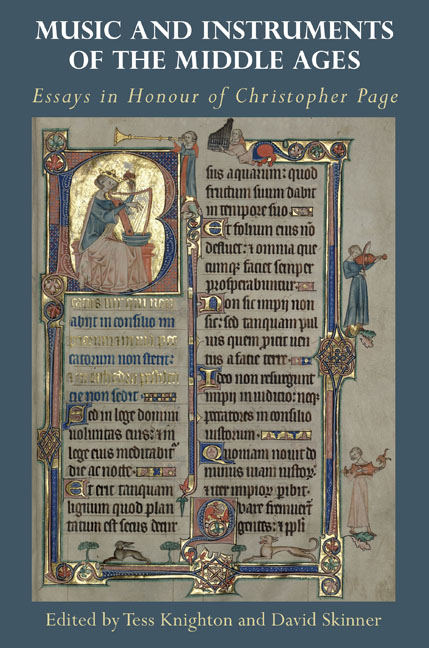Book contents
- Frontmatter
- Contents
- List of Illustrations
- List of Music Examples
- List of Tables
- List of Contributors
- List of Music Manuscript Sigla
- Acknowledgements
- Introduction
- SONGSTERS AND THEIR REPERTORIES
- CLOSE READINGS
- CREATING POLYPHONY
- MUSIC AS CULTURAL PRACTICE
- Works Cited
- Works by Christopher Page
- Index
- Tabula Gratulatoria
- Studies in Medieval and Renaissance Music
1 - The Progeny of Bernart de Ventadorn’s Can vei la lauzeta mover
Published online by Cambridge University Press: 24 November 2020
- Frontmatter
- Contents
- List of Illustrations
- List of Music Examples
- List of Tables
- List of Contributors
- List of Music Manuscript Sigla
- Acknowledgements
- Introduction
- SONGSTERS AND THEIR REPERTORIES
- CLOSE READINGS
- CREATING POLYPHONY
- MUSIC AS CULTURAL PRACTICE
- Works Cited
- Works by Christopher Page
- Index
- Tabula Gratulatoria
- Studies in Medieval and Renaissance Music
Summary
Bernart de Ventadorn's canso Can vei la lauzeta mover was, and arguably is still, the most famous of all troubadour songs. Its text is extant in twenty-two manuscripts, of which three include music. The melody was borrowed for an Occitan contrafactum, three Old French contrafacta and a Latin contrafactum. The song has been edited and translated numerous times; philologists have offered various interpretations of the text and its theme; and musicologists have examined its musical style and structure. Many scholars have queried why the song was so popular and even have attempted to identify a version closest to Bernart's ‘original’.
In this study I do not intend to debate any of the analyses that have been offered or to answer questions about popularity or origins. My goal is twofold: first, to compare closely the variant musical readings of concordances and contrafacta; and second, to explore relationships among the music and the different texts. My hope is to shed light on the song's transmission and the roles of scribes and singers in shaping the melody as we have received it, and to bring to light ways in which text and music may have been adapted in different versions.
TEXT AND CONCORDANT MUSIC SOURCES
Bernart's song survives in manuscripts produced in Italy, Languedoc, Catalonia and northern France from the middle of the thirteenth century through the first half of the fourteenth century. The three manuscripts that include the song's melody represent these diverse provenances and dates: I-Ma R 71 sup. was copied in Italy around the turn of the fourteenth century; F-Pn fr. 22543 was copied in Languedoc probably by the end of the thirteenth century; and F-Pn fr. 844 was copied in northern France in the late thirteenth century. The text in each manuscript exhibits orthographical, lexicological and grammatical peculiarities to be expected of scribes from these different linguistic cultures.
The stanzas of Bernart's song comprise eight verses of eight syllables each with a rhyme scheme of ababcdcd (-er, -ai, -e, -on). The sources transmit a total of seven stanzas and a four-verse tornada, although only six manuscripts include all stanzas plus the tornada.
- Type
- Chapter
- Information
- Music and Instruments of the Middle AgesEssays in Honour of Christopher Page, pp. 11 - 60Publisher: Boydell & BrewerPrint publication year: 2020

